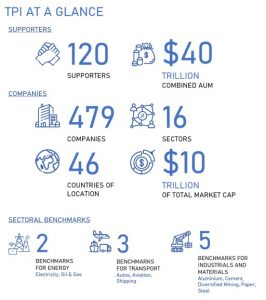In a report published 9 February, the Transition Pathway Initiative (TPI)
published details of the sectoral decarbonisation pathways to help investors judge which companies are on track to transition to net zero between now and 2050.
TPI’s sectoral decarbonisation pathways, which are based on the International Energy Agency’s (IEA) scenarios, allow investors to assess the credibility of corporate net zero commitments. The pathways and the underlying methodologies are publicly available to all.
It’s backed by investors with over $40 trillion of assets under management or advisement. Its benchmark pathways are used by the Climate Action 100+ (CA100+) any by many of the world’s largest and significant asset owners and asset managers.
The report synthesises the methodologies developed by TPI over the past five years, including TPI’s recent work on 1.5 Degrees aligned sectoral pathways – which are new this year following the publication of the IEA net zero scenario.
The pathways are used by investors and investor networks to assess how far companies in their portfolios are aligned with the goals of the Paris Agreement. As an example, TPI’s decarbonisation pathway for aviation states that if an individual company wants to be aligned with a 1.5°C path then its emissions intensity by 2030 must be below 616 tonnes of CO2/RTK (revenue tonne kilometre).
This level of granular detail allows investor to judge companies’ target-setting, and to hold companies to account as their real-world emissions are reported year-on-year. In this way, the benchmarks help inform how investors can assess the Paris-alignment of their portfolios related to this key sectors.
 Simon Dietz, Research Lead for TPI at the Grantham Research Institute on Climate Change and the Environment at LSE said:
Simon Dietz, Research Lead for TPI at the Grantham Research Institute on Climate Change and the Environment at LSE said:
“In order to allow investors to see whether a company’s emission reduction plans align with the goals of the Paris Agreement, TPI has translated IEA models into decarbonisation pathways for each sector.
“This report explains our methodology in an accessible way. We hope this report catalyses the real economy transition plans that we urgently need to avoid the most catastrophic effects of global warming. It is now time to turn commitment into action.”
Key features of the TPI sectoral decarbonisation pathways:
- 1. Sector-specific methodologies are based on the Sectoral Decarbonisation Approach,
allocating an absolute, economy-wide emissions budget to each sector. - 2. Sectoral benchmarks are derived from IEA modelling – showing scenarios meeting 1.5
degrees, below 2 degrees, and aligned with National Pledges – for most sectors1. - 3. TPI benchmarks cover the majority of lifecycle emissions in each sector.
- 4. The benchmarks extend to 2050, allowing investors to see a company’s transition
pathway in the short, medium, and long term. - 5. In nearly all sectors, company emissions are normalised against a physical activity
output – allowing comparison between companies. - 6. The benchmark methodologies can be adapted to new models and scenarios.
- 7. The benchmarks and methodologies are available for everyone to use.
The sectors covered are within Energy (Electricity, Oil & Gas), Industrials (Aluminium, Cement, Diversified Mining, Paper, Steel), and Transport (Autos, Aviation, Shipping).
Adam Matthew, Chair, Transition Pathway Initiative, and Chief Responsible Investment Officer, Church of England Pensions Board said:
“TPI’s sectoral decarbonisation pathways meet the demand from all stakeholders – investors,
companies, civil society organisations – for a credible, rigorous framework for assessing corporate climate change performance. They are recognised by investors as the authoritative
translation of the IEA’s scenarios into credible performance benchmarks for industry sectors
and for individual companies.
“In a world where we are faced with multiple interpretations of what the low carbon transition
should look like (often with the intention of slowing rather than accelerating the rate of
change, and often to argue for less ambitious action by companies), it is imperative that we
as investors make decisions based on credible, rigorous analysis that is explicitly focused on
the goal of net zero and that reflects the economic, technical and societal realities of the low
carbon transition. The TPI sectoral decarbonisation strategies provide that analysis.”



